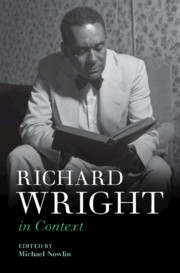Book contents
- Richard Wright in Context
- Richard Wright in Context
- Copyright page
- Contents
- Figures
- Contributors
- Abbreviations
- Richard Wright’s Works: A Chronology
- Introduction Richard Wright’s Luck
- Part I Life and Career, Times and Places
- Part II Social and Cultural Contexts
- Part III Literary and Intellectual Contexts
- Chapter 17 Chicago Sociology
- Chapter 18 1930s Proletarian Fiction
- Chapter 19 The Blues in Print
- Chapter 20 Realism and Modernism, Solipsism and Solidarity
- Chapter 21 The Literary Mainstream: Story and the Book-of-the-Month Club
- Chapter 22 Wright, Psychoanalysis, and Fredric Wertham’s Reading of Hamlet
- Chapter 23 Wright’s Black Boy in Context
- Chapter 24 Wright and Women Authors
- Chapter 25 Existentialism
- Chapter 26 Wright and Les Temps Modernes
- Chapter 27 Wright and Postcolonial Thought
- Chapter 28 Modern Poetry and Haiku
- Part IV Reputation and Critical Reception
- Index
Chapter 23 - Wright’s Black Boy in Context
from Part III - Literary and Intellectual Contexts
Published online by Cambridge University Press: 08 July 2021
- Richard Wright in Context
- Richard Wright in Context
- Copyright page
- Contents
- Figures
- Contributors
- Abbreviations
- Richard Wright’s Works: A Chronology
- Introduction Richard Wright’s Luck
- Part I Life and Career, Times and Places
- Part II Social and Cultural Contexts
- Part III Literary and Intellectual Contexts
- Chapter 17 Chicago Sociology
- Chapter 18 1930s Proletarian Fiction
- Chapter 19 The Blues in Print
- Chapter 20 Realism and Modernism, Solipsism and Solidarity
- Chapter 21 The Literary Mainstream: Story and the Book-of-the-Month Club
- Chapter 22 Wright, Psychoanalysis, and Fredric Wertham’s Reading of Hamlet
- Chapter 23 Wright’s Black Boy in Context
- Chapter 24 Wright and Women Authors
- Chapter 25 Existentialism
- Chapter 26 Wright and Les Temps Modernes
- Chapter 27 Wright and Postcolonial Thought
- Chapter 28 Modern Poetry and Haiku
- Part IV Reputation and Critical Reception
- Index
Summary
Richard Wright published four major books between 1938 and 1945: Uncle Tom’s Children (1938), Native Son (1940), 12 Million Black Voices (1941), and Black Boy (1945). This essay discusses how Black Boy converses with the preceding three books, and how, thereby, they all contextualize each other. They are all migration narratives presenting African Americans moving from South to North in the Great Migration era. They portray black boys including Wright himself migrating from boyhood to young manhood. Collectively, they present Wright migrating into his writing career, his writing self. Once there, he can be a racial “we” and a personal “I.” Special attention is given to how 12 Million anticipates Black Boy. Quite specifically, the racial “we” in 12 Million becomes the “I” in Black Boy who tells his own story and his race’s story of starving variously in a neglectful American nation. The FSA photographs in 12 Million led Wright to see himself and others among the black people portrayed. Hearing the voices, seeing the faces, and seeing himself prepared Wright for composing American Hunger. What came out in 1945 was Black Boy, the portion of his story before he headed North.
- Type
- Chapter
- Information
- Richard Wright in Context , pp. 246 - 251Publisher: Cambridge University PressPrint publication year: 2021

